For additional information relating to this article, please contact:
July 25, 2024POLICE REPORTED CRIME STATISTICS, 2023 Statistics Canada has released the 2023 results for police-reported crime statistics collected under the Uniform Crime Reporting (UCR) Survey. This annual publication measures the volume of crime, crime rates (per 100,000 population), and crime severity (based on sentencing data) by types of crime.
In 2023, Nova Scotia's crime rate (Criminal Code violations excluding traffic) was 5,933.2 incidents per 100,000 population. In comparison, Canada's crime rate for 2023 was 5,843.1 per 100,000 population. This was the third consecutive year that Nova Scotia's crime rate was higher than the national average. The lowest crime rates among provinces were in Quebec and Ontario while the highest were in Manitoba and Saskatchewan.
Halifax's crime rate was 5,665.5 incidents per 100,000 population.
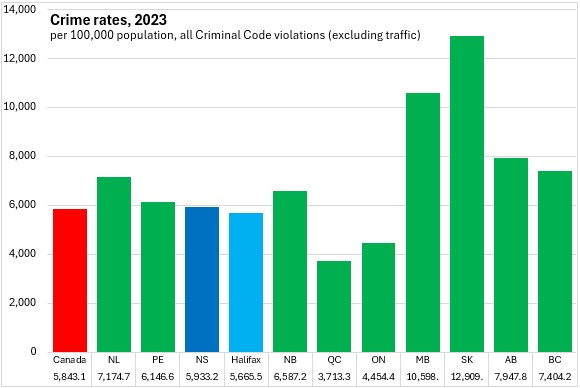
Nova Scotia's crime rate (Criminal Code, excluding traffic) decreased 0.5% in 2023, while there was a 1.5% decrease in Halifax's crime rate.
Canada's crime rate increased by 2.5% in 2023. Crime rates increased in all provinces except Nova Scotia, Manitoba and Alberta. The largest increase in crime rate was reported in Prince Edward Island.
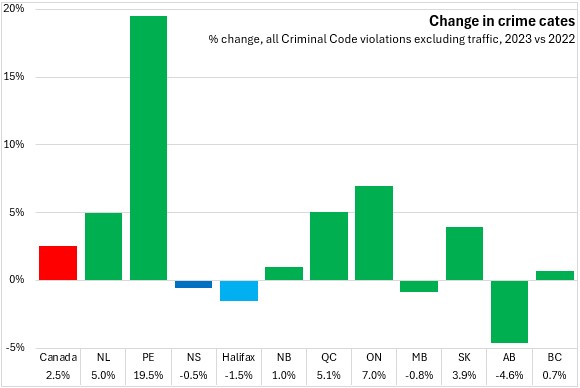
Crime rates declined steadily for many years before bottoming out around 2014 nationally and around 2016 in Nova Scotia. Since then, there has been a rising trend in crime rates (except 2020), though they have not returned to previous high levels.
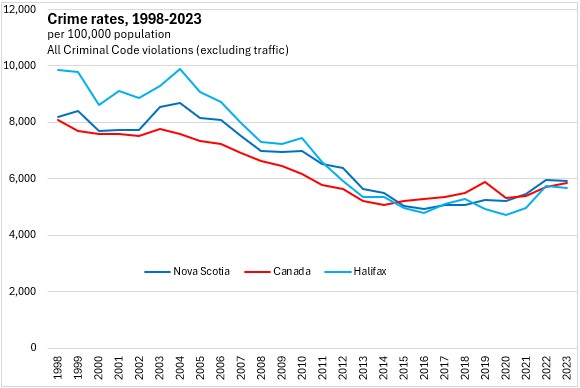
Across Census Metropolitan Areas, crime rates were notably higher in Western Canada with the highest rates in Lethbridge and Kelowna. Although crime rates were higher than the national average in Saskatoon, Regina and Winnipeg, areas outside the cities account more for high crime rates in Manitoba and Saskatchewan.
Crime rates were generally lower across all cities in Ontario and Québec. In Atlantic Canada, Moncton reported a higher crime rate while Saint John's crime rate was lower than in other cities.
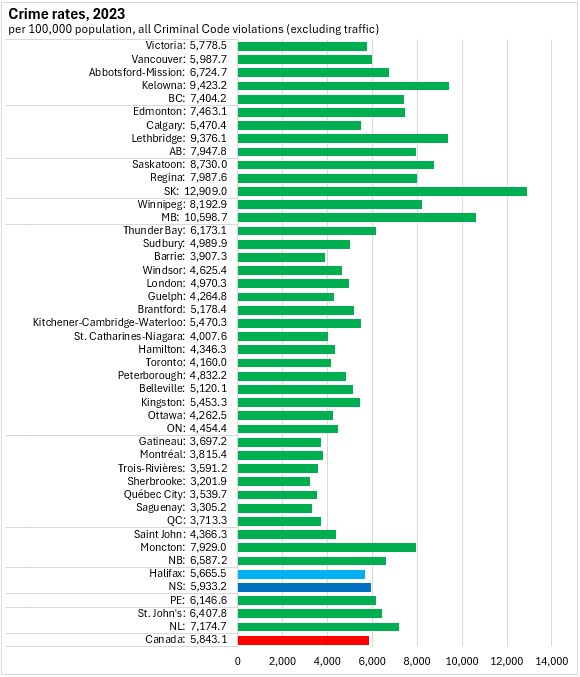
Compared to 2022, crime rates among major urban centres increased the most in Toronto and Abbotsford-Mission. There were notable decreases in crime rates in Kelowna and London.
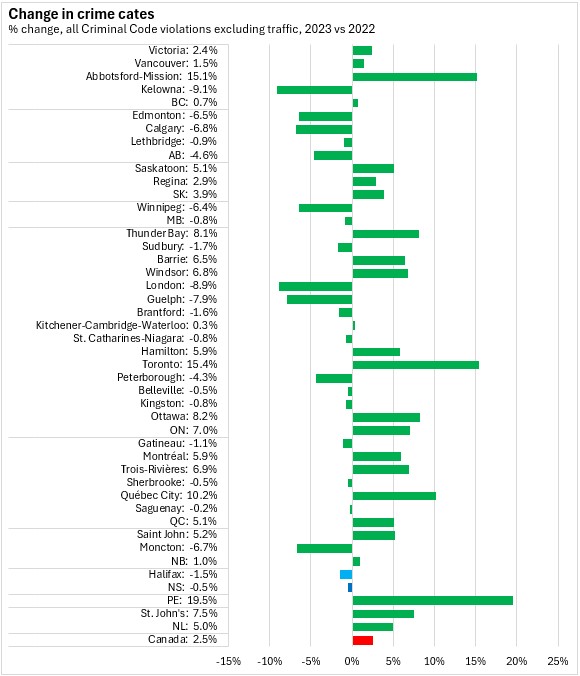
There were 1,612.1 reported violent Criminal Code violations per 100,000 residents in Nova Scotia during 2023. The national violent crime rate was 1,427.9 violations per 100,000 residents. Halifax reported a violent crime rate of 1,464.6 incidents per 100,000 residents.
There were 3,380.2 property violations per 100,000 residents in Nova Scotia and 940.9 other Criminal Code violations in 2023. Halifax reported 3,438.7 property crimes and 762.2 other Criminal Code violations per 100,000 residents in 2023. Nationally, there were 3,391.6 property violations and 1,023.5 other Criminal Code violations per 100,000 residents.
Manitoba and Saskatchewan reported the highest violent and property crime rates in 2023. Saskatchewan also had the highest rate of other Criminal Code violations. Ontario reported the lowest rates of violent crime while Québec reported the lowest rates of property and other Criminal Code violations in 2023.
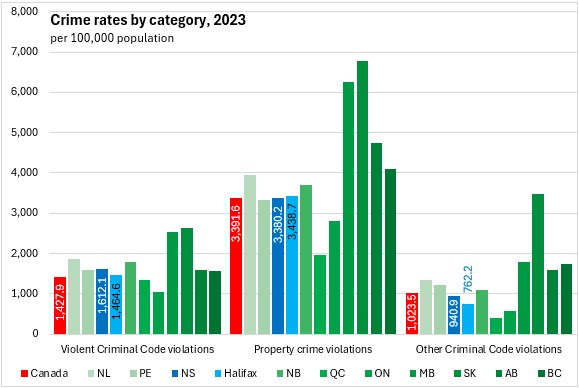
The rate of violent crimes was up 1.1% in Nova Scotia from 2022 to 2023 and down 0.1% in Halifax. Violent crime was up 3.7% nationally with increases in all provinces. Prince Edward Island the fastest rise in violent crime while Nova Scotia reported the slowest increase.
Property crime rates were down 1.3% in Nova Scotia from 2022 to 2023 with a 3.6% decrease in Halifax. Nationally, property crime rates were up 2.0% with the fastest increase in Prince Edward Island. Alberta reported the steepest drop in property crime violations in 2023.
Other Criminal Code violations were down 0.6% in Nova Scotia from 2022 to 2023, though violations were up 6.0% in Halifax. Nationally, other Criminal Code violations grew 2.7% with increases in six provinces. Prince Edward Island had the fastest increase in other Criminal Code violations while Alberta had the largest decline.
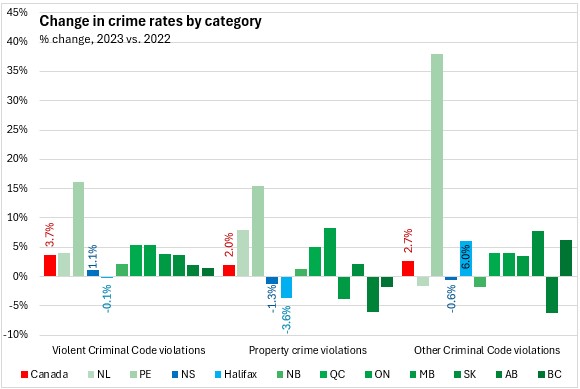
Violent crime rates have been trending up for several years.
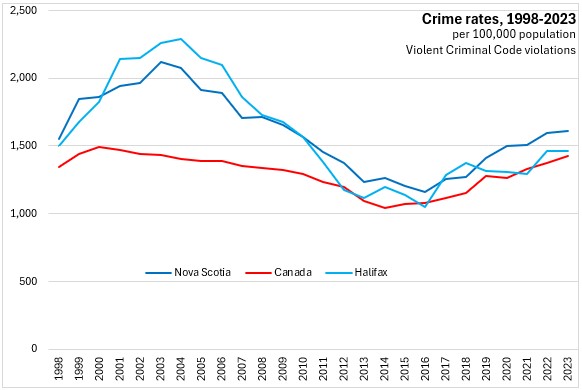
Despite declines in 2023, property crime rates have trended up in recent years.
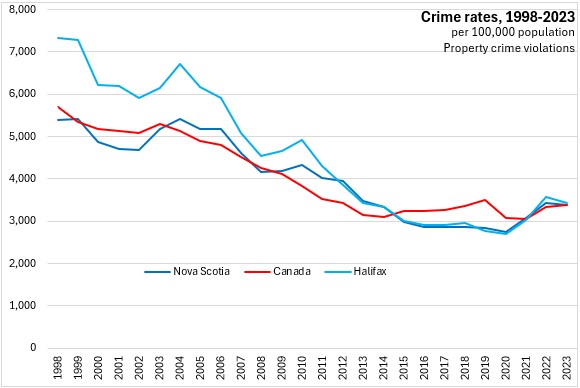
Rates of other criminal code violations increased prior to the pandemic. There were notable declines in other Criminal Code violations in Nova Scotia (particularly Halifax) in 2021. Although the rate of other Criminal Code violations has risen in the past two years in Halifax, it remains below 2019 levels.
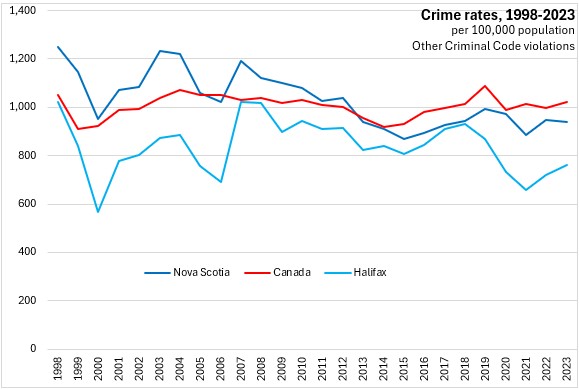
Nova Scotia reported 378.1 Criminal Code traffic violations per 100,000 residents in 2023, which was above the national average of 308.9. There were 241.9 Criminal Code traffic violations per 100,000 residents in Halifax. Criminal Code traffic violations were highest in Prince Edward Island and Saskatchewan (lowest in Ontario).
Nova Scotia's drug violation rate was 92.9 per 100,000 residents while Halifax's was 72.8. The national drug violation rate was 113.6 per 100,000 residents with the highest rates in Newfoundland and Labrador and British Columbia. The lowest drug violation rate was in Ontario.
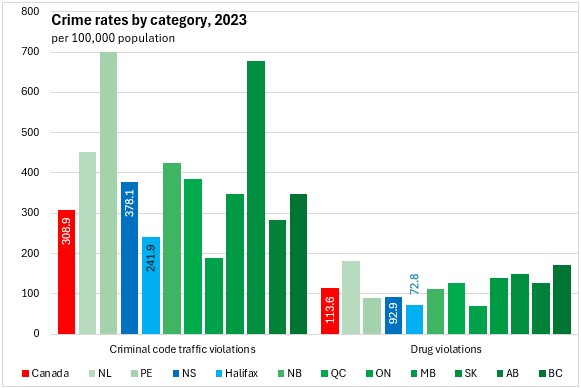
In the last year, Nova Scotia's Criminal Code traffic violations increased by 8.0% (+7.6% in Halifax). Nationally, Criminal Code traffic violations were up 0.7% with the fastest increase in Newfoundland and Labrador (followed by Nova Scotia). Criminal Code traffic violations were down in all four western provinces (as well as New Brunswick) in 2023.
Drug violations increased by 12.0% in Nova Scotia and by 22.3% in Halifax in 2023. Nationally, drug violations were down by 17.1% on a particularly steep decline in British Columbia. Manitoba reported the quickest rise in drug violations among the provinces (followed by Nova Scotia).
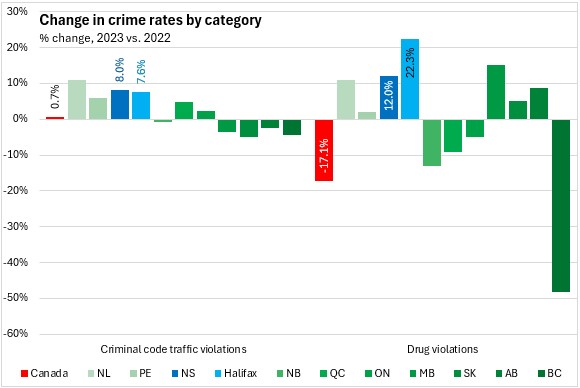
Criminal code traffic violations increased for the first time since 2019 in Nova Scotia.
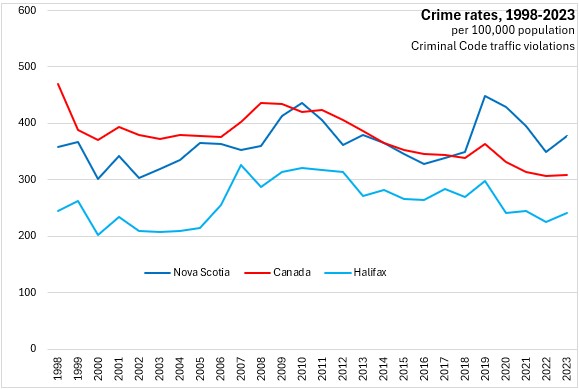
Although there was an increase in 2023, Nova Scotia's drug crime rates remain substantially lower than they were prior to 2018.
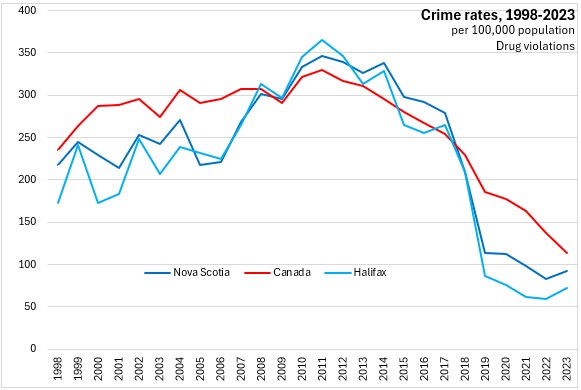
Nova Scotia's youth crime rate in 2023 was 3,048.3 violations per 100,000 residents aged 12-17, which was higher than the national youth crime rate (2,898.1). The youth crime rate was lower in Halifax (2,680.7). Youth crime rates were higher in Manitoba and Saskatchewan. Note the youth crime rates are divided into youth who are charged for a reported crime as well as youth who are not charged for a reported crime.
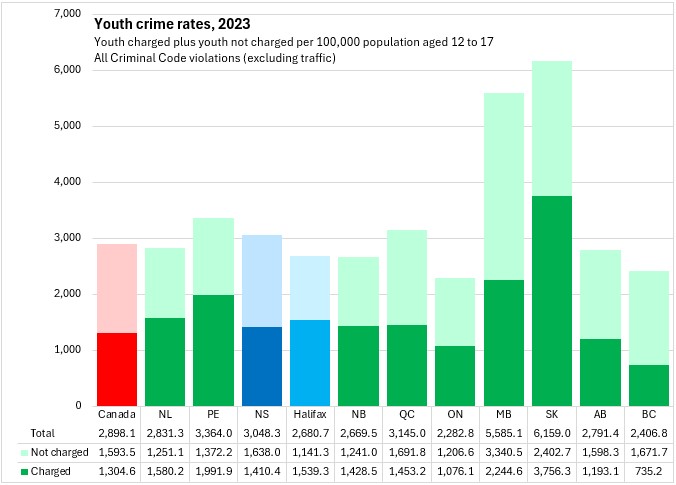
Youth crime rates were up in every province last year, particularly in Prince Edward Island, where youth crime almost doubled. Youth crime in Nova Scotia increased by 16.1% in 2023, including a 40.3% rise in Halifax. Nationally, youth crime was up 12.7% with the slowest growth in New Brunswick and Alberta.
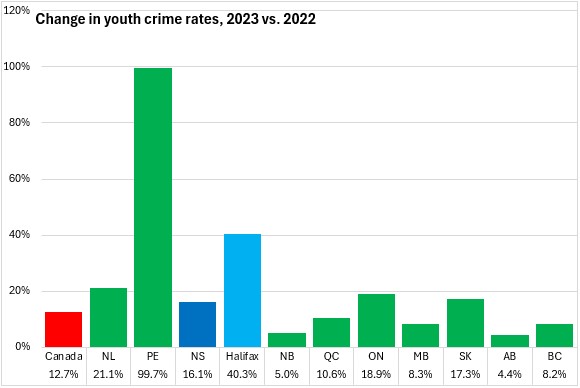
Crime severity
The overall severity of crime, as measured by the Total Crime Severity Index (CSI) was 73.8 in Nova Scotia and 72.0 in Halifax. The national average crime severity was 80.5 with the highest rates in Manitoba and Saskatchewan and the lowest rates in Ontario and Québec.
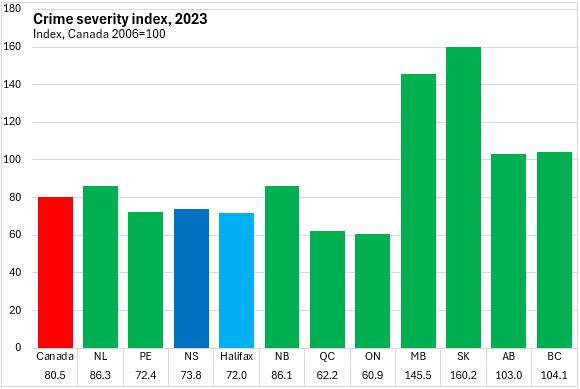
Across municipalities, Winnipeg and Lethbridge reported the highest crime severity rates while and Barrie reported the lowest crime severity rate. Most cities in central and Atlantic Canada reported crime severity below the national average with the exceptions of Thunder Bay, Moncton and St. John's.
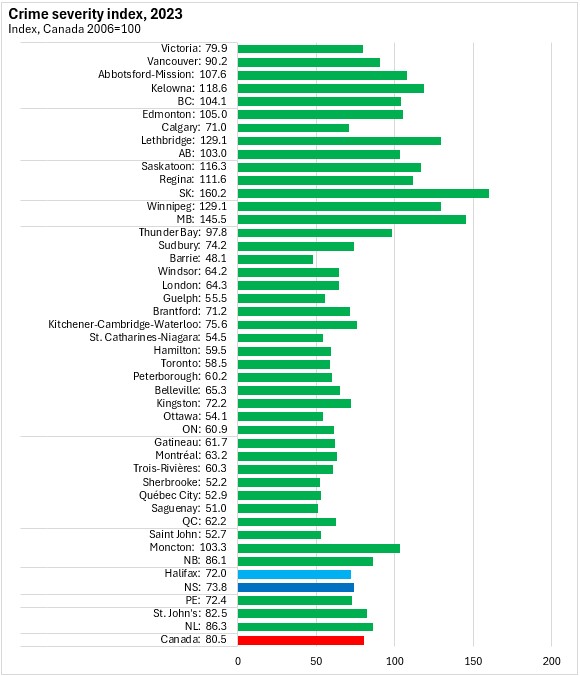
The crime severity index decreased 1.3% in Nova Scotia from 2022 to 2023 with a similar decline for Halifax. Nationally, crime severity was up 2.1% with increases in six provinces led by Prince Edward Island. Alberta reported the steepest decline in crime severity.

Among cities Abbotsford-Mission reported the fastest rise in crime severity. London reported the largest decline.
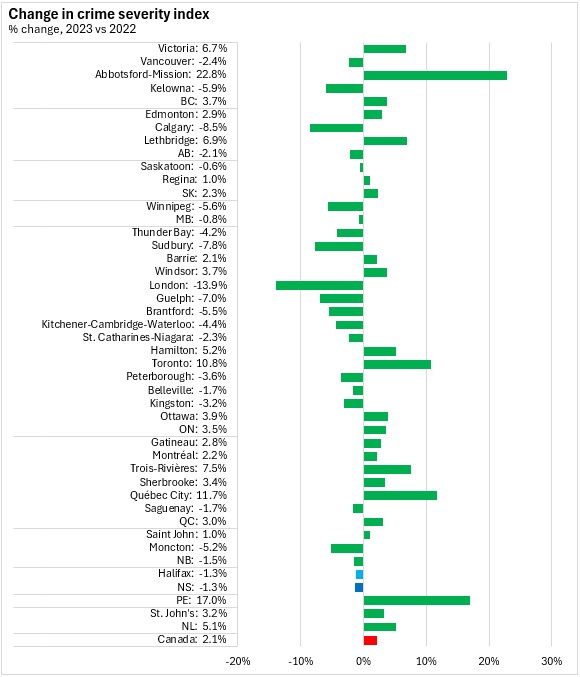
Like crime rates overall, the crime severity index declined for several years before rising slowly in the most recent decade.
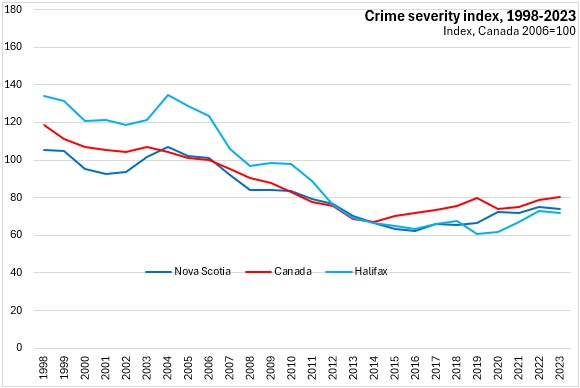
The severity of violent crimes has had a sharper increase in the last decade.
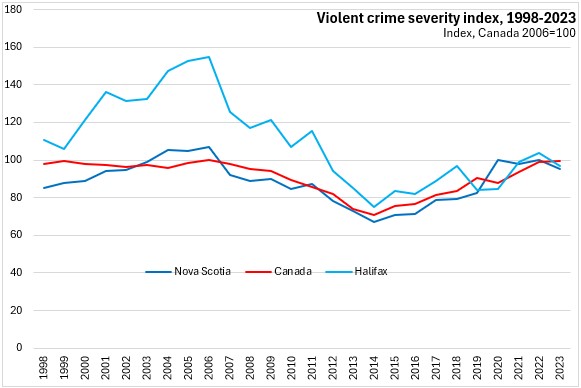
There have been increases in the severity of non-violent crimes in each of the last two years for Canada, Nova Scotia and Halifax.
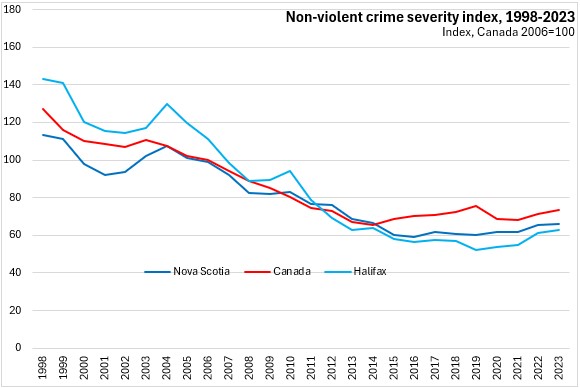
NOTE: on January 1, 2018, Statistics Canada, in collaboration with police, changed the definition of “founded” criminal incidents. With the new definition, there is the potential that police will classify more incidents as founded.
Definitions:
Incident (or Offence): A criminal incident involves one or more related offences that are committed during a single criminal event and have been reported to police.
Violent offences: Involve the use or threat of violence against a person, including homicide, attempted murder, assault, sexual assault and robbery.
Non-violent offences: Include property offences and other Criminal Code offences, as well as Criminal Code traffic offences, drug-related offences and violations of other federal statutes.
Sexual assault: Is classified by level in the Criminal Code into three separate categories—depending on the nature and severity of the incident—including level 1, assault of a sexual nature that violates the sexual integrity of the victim; level 2, sexual assault with a weapon or causing bodily harm involves sexual assault with a weapon, threats to use a weapon or causing bodily harm; and level 3, aggravated sexual assault involves sexual assault that wounds, maims, disfigures or endangers the life of the victim.
“Other” Criminal Code offences: Include crimes such as disturbing the peace and offences against the administration of justice (e.g., failure to comply with an order, failure to appear and breach of probation).
Source: Statistics Canada. Table 35-10-0026-01 Crime severity index and weighted clearance rates, Canada, provinces, territories and Census Metropolitan Areas, Table 35-10-0177-01 Incident-based crime statistics, by detailed violations, Canada, provinces, territories and Census Metropolitan Areas